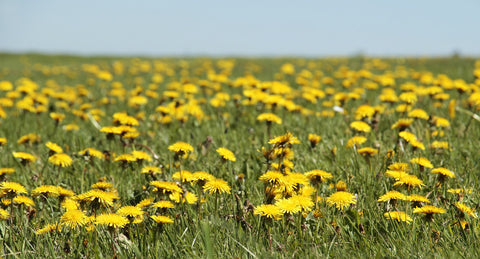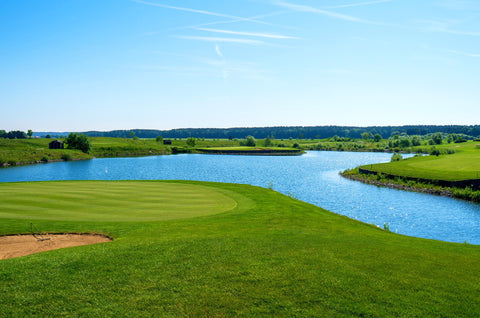WEED CONTROL IN LAWNS
Your lawn may grow more than the beautiful grass you intended. It may also grow weeds, which prevent your lawn from looking its best. In addition to reducing the aesthetics of your lawn, weeds compete with the desired turfgrass for water, nutrients, and light. If you don’t control weeds, your lawn will deteriorate over time. Weeds are often a symptom of a cultural or soil problem that exists in your lawn. So, weed control involves both removing the weeds and correcting the conditions that lead to inferior-quality turf.
Cultural Control
Growing healthy dense turf is the best way to prevent weeds. Vigorous, healthy turf shades weed seeds, so they don’t germinate. Select suitable lawn grasses, fertilize properly (especially in fall), lime as needed based on soil test recommendations, mow frequently only removing 1/3 of leaf tissue with each cutting, water during establishment and only to keep lawn green during drought. When you water, be sure to thoroughly soak soil weekly. Frequent, light watering encourages weed encroachment, discourages deep rooting, and lowers the environmental stress tolerance of turfgrasses. Aerate and add compost to improve soil structure. To have a beautiful, healthy lawn you need a basic knowledge of turfgrasses and their cultural requirements.
Chemical Control
Herbicides, chemicals that kill or alter the normal growth of weeds, can be divided into two main groups: selective and nonselective.

Selective herbicides control the target weed without damaging desirable turfgrasses.
Nonselective herbicides kill all vegetation (including turfgrasses) and are used in lawn renovation or for weeds not controlled by selective herbicides.
Herbicides can be further divided into pre-emergence and post-emergence categories.
Pre-emergent herbicides are applied prior to germination and weed emergence. They are typically used for controlling annual weeds.
Post-emergent herbicides are used for controlling weeds that have already emerged from the soil. They are either systemic or contact in nature. Contact herbicides affect the plant parts they touch and are not translocated to other parts of the weed. Systemic herbicides are translocated throughout the plant, so they are effective at killing perennial weeds that can generate new foliage from underground roots. Herbicides can be applied to foliage or soil. Post-emergent herbicides are usually foliar applied, and pre-emergent herbicides are soil applied. A foliar-applied herbicide must contact and be absorbed by the foliage. It is less effective if washed off the leaf surface by rainfall or irrigation. Soil-applied herbicides can be applied as liquids or granular and should be watered into the soil following application. The best way to think about controlling weeds in lawns is to figure out how the weed differs from the desirable grass and use that difference as a means of control.
Annual Grass Weeds
Summer annual grass weeds are common problems in lawns. They differ from desirable lawn grasses because they must germinate each year. Crabgrass and Goosegrass are two common summer annuals. These weeds are controlled with pre-emergent herbicides that form a chemical barrier in the soil prior to germination or emergence. The barrier prevents the seedlings from emerging and developing normally.
PRE-EMERGENCE HERBICIDES FOR THE CONTROL OF SUMMER ANNUAL GRASSES:
| Generic Name | Trade Name |
|---|---|
| Dithiopyr | Dimension |
| Oxadiazon | Ronstar |
| Pendimethalin Pre-M | Pendulum |
| Prodiamine | Barricade |
Most pre-emergent herbicides remain active in the soil, so seeding should be postponed for the amount of time specified on the manufacturer’s label. Siduron is the only material that can be safely used during or immediately following seeding. Timing of pre-emergent herbicides is critical. The best time to apply pre-emergent herbicides is approximately 10 to 14 days before the expected germination period in spring. Crabgrass begins to germinate when soils are moist and the temperature in the upper inch of soil reaches 55°- 58° F at daybreak for four to five days. Forsythia petal fall is sometimes used as a guideline but may not be reliable. In Maryland, crabgrass usually germinates between March 15 and April 15. Depending on the product, time of application, location and rainfall in the spring, reapplication may be necessary within 60 days for season-long control.

If pre-emergent herbicides are applied too late, you may need to use a post-emergent herbicide for summer annual grass control. Apply post-emergent herbicides when the crabgrass or other annual weed is fully visible and apply only to patches of weeds. As crabgrass becomes larger, it is more difficult to control. You may need to use repeat applications at 10 - 14-day intervals and expect to see some yellowing on desired turfgrass.
POST-EMERGENT HERBICIDES FOR THE CONTROL OF SUMMER ANNUAL GRASSES
| Generic Name | Trade Name | Controls |
| Fenoxaprop-p-ethyl | Acclaim Extra | Goose Crabgrass |
| MSMA | MSMA Turf Herbicide | Goose Crabgrass |
| Quinclorac | Drive 75 DF Herbicide | Goose Crabgrass |
BROADLEAF WEEDS
Broadleaf weeds differ from desirable lawn grasses in their chemistry and morphology. Scientists have been able to develop selective products that control broadleaf weeds without harming desirable turfgrasses. Broadleaf weeds are primarily controlled with herbicides that are applied after weeds have emerged. These herbicides are applied to foliage and are absorbed into the weeds. These herbicides may be applied as a spray or a granular. For the most effective control of broadleaf weeds apply post-emergent herbicides as sprays to foliage (don’t wash off). Granular products should be applied to moist (dew-covered) foliage for optimum control. Post-emergent broadleaf herbicides are most effective when weeds are actively growing (spring and fall) and when temperatures are between 70° - 85°F. Two or more different herbicides are frequently sold in combination to provide control of multiple broadleaf weeds simultaneously. It is important to identify the weed(s) to be controlled because many of these herbicides are selective to specific broadleaf weeds. These products have the potential to damage trees, shrubs, flowers, and vegetables if they contact the foliage. Trees and shrubs are particularly sensitive to dicamba since this herbicide is mobile in the soil and can be taken up by tree roots. Do not use any of these herbicides on newly seeded turf. Wait until the new lawn has been mowed at least 3 times before treating (usually about 6 - 8 weeks after seedling emergence).

BROADLEAF HERBICIDES AND HERBICIDE COMBINATIONS FOR USE IN COOL-SEASON GRASS
| Generic Name | Trade Name |
|---|---|
| 2,4-D (amine) | Trimec |
| Carfentrazone-ethyl | Quicksilver |
| Dicamba (amine) | Banvel, K-O-G Weed Control |
| Lockup | Penoxsulam |
| MCPP (amine) | MCPP-p 4 Amine |
| Triclopyr (ester) | Turflon Ester |
Nutsedge
Yellow nutsedge is a common turfgrass weed that looks like a grass but is actually a sedge. It has erect, triangular-shaped stems that are yellow-green, with a thick mid-vein and a waxy surface. The shallow, fibrous root system often produces many nut-like tubers, which are underground food storage organs. Each of these tubers can germinate and produce a new plant. Yellow nutsedge thrives in warm, wet conditions and is often found in low-lying areas of the lawn with poor drainage. If only a few nutsedge plants are present, they can be removed by hand pulling. Remove the entire plant and the root system by digging under the plant. Where large patches of nutsedge are present, herbicides may be required. Selective herbicides have been developed that will control this sedge without harming the desirable turfgrass.
Perennial grass weeds

Perennial grass weeds are not much different from desirable turfgrasses except they compete with desired varieties. Bent grass, which is highly desirable on a golf green is a weed in the lawn, due to its soft, fine-bladed tufty habit. Wiregrass, common throughout the state, spreads rapidly by tough wiry stems. This warm season grass goes dormant in the winter. Nimblewill is a blue-green, thin-bladed grass with wiry stems that form patches, like bent grass. Several species of Paspalum can be found in lawns. One called Dallasgrass is a course, yellow-green, warm-season clump grass. Seed spikes have characteristic flat, rounded seeds. The only mechanism for control of these perennial grasses is to use a non-selective herbicide, kill the entire patch of lawn infested with the weed, and re-seed with desirable turfgrass once the weed is gone. Glyphosate is a non-selective herbicide that can be used for this type of control. Weed Terminator 20 is an all-organic alternative to Glyphosate  and is extremely effective, the Mill is the local distributor for Weed Terminator which is a concentrated acetic acid product (strong vinegar base) for commercial and residential use and works within hours.
and is extremely effective, the Mill is the local distributor for Weed Terminator which is a concentrated acetic acid product (strong vinegar base) for commercial and residential use and works within hours.
The Mill supplies many Pre- and Post-emergent products to combat weeds in lawns:
- 16-0-5 .13 Dimension Pre-emergent crabgrass control Lebanon 4 bags to acre
- 13-0-5 30% SCU .15 Dimension Lebanon Pre-Emergent 4 bags to acre
- 18-0-4 Prodiamine Pre-emergent Crabgrass Control Lebanon 3 bags to acre
- 25-0-8 with Trimec Weed'n Feed Post-emergent Broadleaf 3 bags per acre
- 18-0-4 25% PCU Lockup Post-emergent 3 bags per acre
- 19-0-6 Lockup/Dimension Pre- AND Post-emergent 4 bags per acre
- 0-0-7 Lockup Post-emergent 3 bags per acre No Fertilizer
- Trimec Granular No fertilizer 3 bags per acre
- Trimec Classic Spray Post-emergent
- Strike 3 Spray Post-emergent
- T-Zone Spray Post-emergent
- Weed Terminator 20 All-Natural alternative To Glyphosate
Common Grassy and Broadleaf Weeds in Maryland
Grassy weeds
Bermudagrass, Crabgrass, (large and smooth) Creeping bentgrass, Foxtails, Nimblewill, Quackgrass, Zoysiagrass, Goosegrass
Non-grass Monocots
Wild garlic, Yellow nutsedge
Broadleaf weeds
Broadleaf plantain, Buckhorn plantain, Dandelion, Violets, Chickweed, Canada thistle, Ground ivy, Common lambsquarter, Hairy Bittercrest, Field bindweed, Henbit, Hedge bindweed, Honeyvine milkweed, Poison ivy, Mouseear chickweed, Pokeweed, Purple deadnettle, Prostrate knotweed, purple loosestrife, Purslane, Ragweed (common), Redroot pigweed, Ragweed (giant), Speedwell, Velvetleaf, Spotted spurge, White clover
Need Help with deciding how to best manage weeds in your lawn?
The Mill can Help! Stop in to any store or reach out to The Mill's Turf Specialist to schedule a Lawn Consultation at jvinson@themillstores.com












